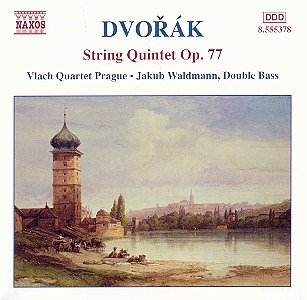The music of Czech composer Antonín Dvorák is, in my opinion, every bit as consistent
as that of Johannes Brahms, his contemporary and artistic benefactor.
Of course, he is famous for his “New World” symphony and the Slavonic
Dances, but some of his finest and most appealing work lies in the large
body of chamber music that he contributed to the repertoire. This excellent
recital by the Vlach Quartet Prague with guest
bassist Jakub Waldmann
presents us with a splendid diamond (the opus 77 quintet) set amongst
a lovely array of smaller gems.
Born about forty miles north of Prague, Dvořák
was the eldest son of a butcher and innkeeper. Fate might have had him
taking on his father’s trade were the elder Dvořák not himself
an amateur musician who recognized young Antonín’s
exceptional talent early on. After primary schooling in his hometown
he moved in with his uncle in Zlonice where
he would acquire the necessary knowledge of German to allow him admission
into the Organ School in Prague; he studied there from 1857-1859. He
would go on to play viola in the Czech Provisional
Theatre Orchestra, which was conducted for a time by Bedrich Smetana. In 1871, he would resign his post to pursue
composition full time.
An application for an award from the Austrian government
in 1874 brought Dvořák’s music to the
attention of the influential critic Eduard Hanslick,
and later of Johannes Brahms who was a member of the jury. The granting
of this award for five consecutive years was of great financial assistance
to the budding composer, and its prestige was sufficient to enable Brahms
to convince the publisher Simrock to issue
some of Dvořák’s music to the broader public. In 1891, he would
be appointed professor of composition at the Prague Conservatory, and
in the summer of the same year, American philanthropist and arts patron
Jeannette Thurber saw to his invitation to head the National Conservatory
of Music in New York. Some of
Dvořák’s most famous music was composed in the United States, including the American string quartet and the ninth symphony. He
returned to Prague to resume his post at the conservatory in 1895, becoming director
in 1901. He remained in the post until his death in 1904.
The opus 77 quintet for strings was completed in 1875.
Originally in five movements, Simrock’s misleading
opus number makes it seem a more mature work than it is. The Vlach with Mr. Waldmann give us
a fine if not perhaps too careful performance here. I found that tempi
were a bit overly cautious, particularly in the delightful second movement
scherzo, which to my ears pleads to be played with a good deal more
giusto. The melodies, so reminiscent of a rollicking
folk dance, lack the confidence and panache of a carefree celebration
in this subdued rendition. That quibble aside, there is little
to criticize in the meticulously phrased and flawlessly tuned playing
of this ensemble. They particularly shine in the lyrical third movement
where singing melodies and a lovely balance of voices rule the day.
Perhaps the most appealing music in this program
is not the major work, but the little gems that follow it. The Intermezzo
(also widely known in its version for violin and piano known as Notturno) is simply gorgeous and is lovingly played
here. The gentle Drobnosti, or miniatures,
were written for a friend of Dvořák’s.
An amateur violinist, Dvořák originally wrote his famous Terzetto
for two violins and viola for his chemist friend. When the earlier work
proved too technically difficult for his non-professional companion,
he created these splendid little pearls. They are played here to perfection,
each splendid melody presented with wit, charm and warmth.
Naxos recording is on the money, with a good balance and warm bloom to the
sound. The musicians do indulge in a bit of audible sniffing and snorting
which is a bit of a distraction, but it is not so obnoxious that it
spoils the program. Notes by Keith Anderson are informative and interesting.
This is a worthy addition to any library, particularly for the shorter
pieces.
Kevin Sutton
